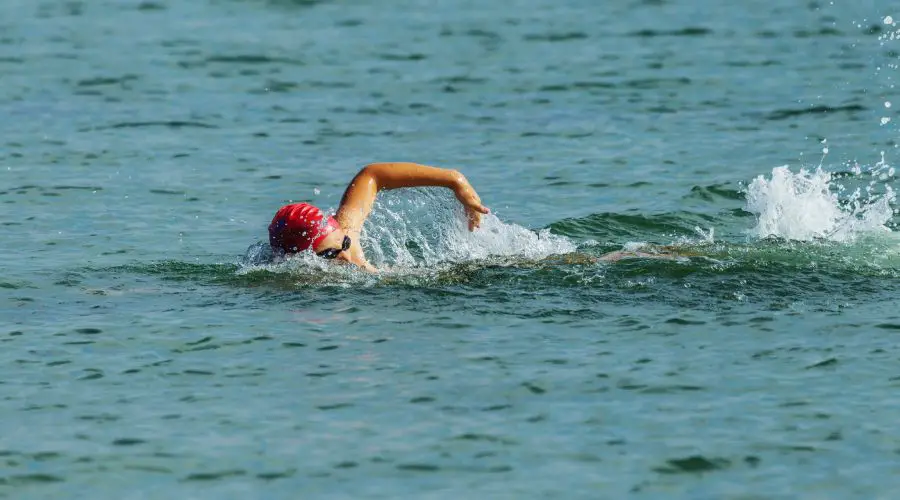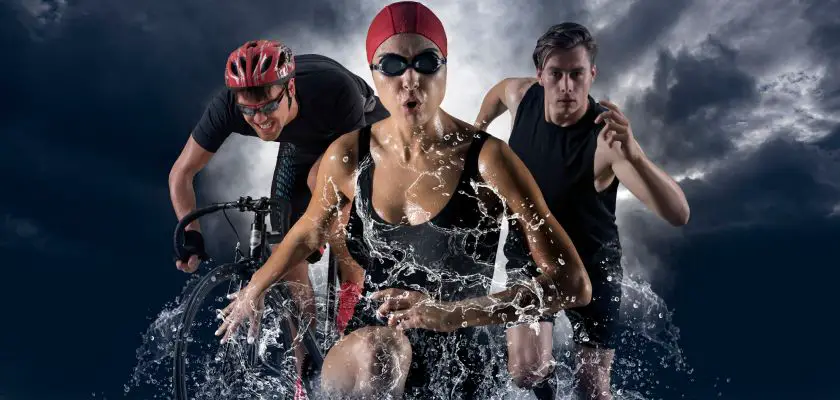Knowing the triathlon rules is the first step to starting to understand and, of course, practicing this sport that challenges athletes to the limit.
Of course, if you’re thinking of venturing into the sport, it’s essential to get medical supervision and seek the support of a trained professional. This way, you’ll increase your chances of achieving faster and healthier results.
In this sense, it’s important to pay attention to the main tips for beginners in triathlon, for example:
- Train for all three disciplines regularly.
- Join a training group or triathlon club.
- Seek professional guidance from a coach.
- Start with shorter distance races.
With that in mind, it’s time to get to know the rules and understand what a triathlon athlete can and can’t do during races.
As you’ll see, we’ve separated this article into two parts: the first with general rules about the sport and the second with specific rules for each category (swimming, cycling and running).
So let’s understand how triathlon works!
Join our free WhatsApp community and receive daily tips, news and trivia on more than 50 sports! Click here to join.
What are the general rules of triathlon?
The triathlon requires the athlete to master three sports: swimming, cycling and running. To win the race, you have to complete the distances set by the organization in the shortest time possible, making the transitions from one category to another and crossing the finish line before your competitors.
Since we’re talking about a sport that includes three disciplines, it’s clear that the athlete who wants to dedicate themselves to the category needs to be ready to train all the skills necessary to win each stage. In other words, they need to master swimming, cycling and running techniques.
Remember that triathlon is not a race in heats, but rather a single “race” in which the clock is ticking.
Therefore, the quality of the transitions between one sport and another is also essential to achieving success at the end.
That’s why we often hear that this transition is the fourth sport.
Triathlon rules for all stages of the race
The triathlon is a multi-sport event whose objective is to complete the three disciplines in the shortest possible time. The order is always the same: swimming, cycling and running. The standard or Olympic discipline is the most commonly practiced, with 1.5 km (0,93 miles) of swimming, 40 km (24,8 miles) of cycling and 10 km (6,2 miles) of running.
However, distances can vary depending on the type of race. To make your search easier, we’ve put together the most common types of race and the most common routes. This way, you can get an overview and have a better idea of the size of the challenge you’re about to face! lol
| Course | Course |
| Sprint (or Short) | 750 m swim 20 km cycling (12,4 miles) 5 km of running (3,1 miles) |
| Olympic, also called Standard | 1.5 km of swimming (0,93 miles) 40 km cycling (24,8 miles) 10 km run (6,2 miles) |
| Long distance, according to the ITU, can be double or even triple the standard distance | 3 km of swimming (1,86 miles) 80 km cycling (49,7 miles) 20 km run (12,4 miles) or 4.5 km of swimming (2,8 miles) 120 km cycling (74,5 miles) 30 km run (18,6 miles) |
| Mixed Relay | 300 m swimming 8 km cycling (4,9 miles) 2 km run (1,24 miles) |
Half-Ironman (70.3) | 1.9 km swim (1,18 miles) 90 km cycling (55,9 miles) 21 km run (13,1 miles) |
| IronMan | 3.8 km of swimming (2,4 miles) 180 km cycling (111,8 miles) 42.2 km run (26,22 miles) |
| Ultra IronMan (3 days of competition) | Day 1: 10 km (6,2 miles) swim followed by 145 km of cycling (90 miles). Day 2: 276 km of cycling (171,4 miles). Day 3: 84 km of running (52 miles). |
The most complex triathlon race is the Ultraman, the only one contested over more than one day, due to the difficulty and distances that need to be covered.
The Sprint, on the other hand, is the shortest of the races and is ideal for those who are just starting to develop in the sport.
The famous Ironman is also one of triathlon’s best-known races and is a dream for many athletes.
So, would you take on 3.8 km of swimming, 180 km of cycling and 42.2 km of running, without stopping and without rest?
Triathlon rules for the start
The rules for starting a triathlon can vary depending on the type of race and the specific regulations of the event. Generally, the start of a triathlon is a mass start, with all the athletes starting at the same time. However, some competitions divide athletes by age. In these cases, the start is made in “waves”.
Each wave consists of a group of athletes who start together, usually separated by age category, gender, or skill level.
This helps to avoid crowds in the water and makes the competition safer.
It’s worth remembering that the first discipline in triathlon is swimming.
Triathlon rules for swimming
Swimming in the triathlon can take place in the open sea, in a lake or even in a swimming pool. To start the competition, all the athletes are positioned side by side. In open water, marker buoys are used to delineate the course. Athletes must swim around them in a straight line. Deviations may result in penalties.

After entering the water, you are allowed to perform the style of swimming you wish, but be careful not to disturb the other competitor’s performance. When this happens, you can also be penalized.
It’s also worth talking about drafting, the technique of staying on another swimmer’s mat to reduce effort. It can be allowed or forbidden, depending on the rules of the event you’re taking part in, ok?
So stay tuned to avoid penalties that could hinder a good result.
However, if drafting is allowed, it is still common for there to be limitations on the distance and time in which one swimmer can fall behind the other, and benefit from it.
Another rule of swimming the need for athletes to wear appropriate swimwear while swimming, and wetsuits may be allowed in colder waters.
To avoid punishments, the main tip about triathlon rules is to keep an eye on the race organizers’ instructions. These are usually shared with athletes when they register for the race.
Transition 1
The first transition is the switch from swimming to cycling and takes place as soon as the athletes get out of the water and head for the first transition. Here they leave their swimming gear and pick up the items they need for cycling, including, of course, the bike.
At this stage, they need to change clothes and put on their cycling shoes. Here, it’s important to make it clear that a change of clothes is compulsory.
In other words, you can’t go cycling in your swimming gear to “save time”, and you can’t cycle barefoot! 🥴
Triathlon Rules for Cycling
Among the triathlon rules for the cycling stage, the main one is the need to wear helmets. The equipment must be correctly adjusted and fastened under the chin. Participants should only mount their bikes after leaving the transition area.
Once again, they must follow the route designated by the race organizers, and the use of shortcuts is prohibited. Such deviations can result in penalties or disqualification.
In addition, it is essential to pay attention to the choice of bicycle equipment, which must comply with safety regulations, including:
- functional brakes
- handlebars with suitable ends;
- pedals similar to those of road or mountain bikes.
Transition 2
The second transition is the move from cycling to running. As well as leaving the bike, the athlete needs to change clothes and put on their running shoes as soon as possible.
Athletes must mount and dismount from their bikes only in the designated transition area and must follow the instructions of the volunteers and referees during these transitions.
To avoid wasting time, it is essential that you are familiar with the rules of the race, which are usually shared at registration. So keep an eye on your pre-test preparation!
Triathlon Rules for Running
The run is the last stage of a triathlon race and it is not permitted to run barefoot or shirtless. Therefore, in the transition area, the competitor puts on their running shoes and then runs the predetermined distance. As this is the last part of the race, whoever completes it first wins.
Participants must start the race from the transition area or a designated place, as indicated by the event organizers’ instructions. Be aware that official authorization is required to start the race.
In addition, athletes may not receive outside assistance during the running segment, except at the designated hydration points.
When the race ends
There is no minimum race time, which means that the winner of the race is the person who crosses the finish line first.
In short, the main rules of triathlon include:
- Performing the disciplines in the following order: swimming, cycling and running
- Follow the indicated route (no shortcuts or detours)
- Proper use of clothing according to the sport
- Prohibition of a participant intentionally harming another athlete
- There will be one start and two transitions between disciplines
- The first to cross the finish line is the champion.
These are the main rules of triathlon, but it’s important to note that they may differ depending on the event you’re taking part in.
So when you sign up for a competition, make sure you read the instructions and regulations provided by the organizers, okay?
If you’re a sports fan, take the opportunity to find out more about some of them by following our blog and our content. See more at:
- All about Triathlon: rules and characteristics of the super sport [3 in 1]
- All about swimming: history, competitions, rules and curiosities
- Types of football: meet 14 variations of the game



